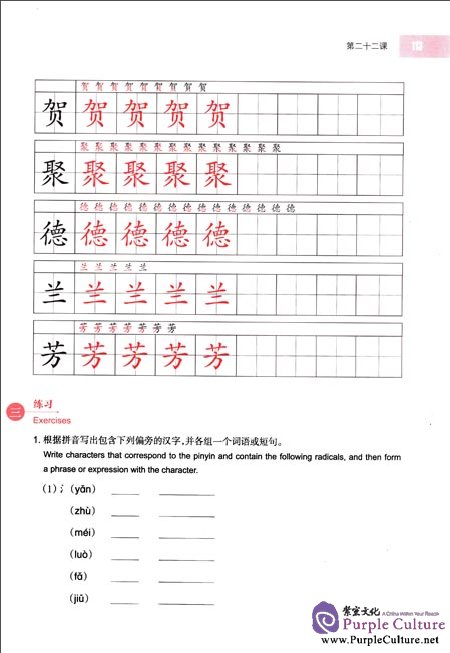Sample Pages Preview


汉字的偏旁(一)
Radicals of Chinese Characters(1)
从已学的汉字中,我们可以看到,有些汉字形体的某个组成部分(字素)是相同的,如"语、谁、请、谢"中的"讠";"你、他们、信、作、什"中的"亻";"吗、哪、叫、呢"中的"口"等。这些相同的部分就是汉字的偏旁。掌握汉字的偏旁,对记汉字、查字典很有帮助。
Some of the characters that we have come across share the same components.For instance,语,谁,请,and谢have the common component 讠;你,他,他,信,作and什have the common component 亻;and吗,哪,叫,and呢have the common component口.A component that a number of characters share is known as a radical.To remember Chinese characters and to be able to look them up in a dictionary,one should have a good mastery of radicals.
语、谁、请、谢、讨、让、讲、诉、词、认、记、识、辩
你、们、他、信、保、体、作、住、什、休、借
吗、哪、叫、呢、吃、听、味、唱、喊、喝、嘴、问
汉字是表意文字。汉字的偏旁有的表达一定的意义。如"讠"是"言(yán,language;to speak)"的简化,所以带"讠"的字往往与说话有关;"亻"是"人"演变来的,带有"亻"的字往往与人有关;带有"口’,的字往往与嘴有关。
As the Chinese written forms originated from ideograms,their radicals mostly hold meanings.For example,characters containing the radical 讠,the simplified form of言,signifies"speech";the radical 亻,originated from the character人,is often used to form a character referring to people;characters with the radical口indicate something that has to do with a human mouth.

